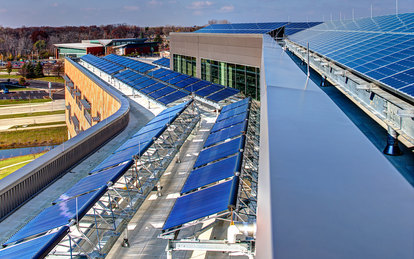Photovoltaics – No longer the Ugly Ducklings of Design

Solar power is now cost competitive with fossil fuel energy and gaining widespread adoption.
Solar power is now cost competitive with fossil fuel energy and gaining widespread adoption. But can architects implement this environmentally friendly technology without creating an eyesore?
Let’s be frank. Performance criteria has long been in the driver’s seat of photovoltaic (PV) design. Cost-conscious engineers try to design the most efficient system to get the biggest bang for their buck. With performance trumping aesthetics, the architect had basically two choices: make the PV modules invisible or integrate them into the overall concept just like any other building element or material.
Fortunately, the PV industry is getting smarter concerning aesthetics and there are now more ways for architects to pursue the latter option. Simultaneously, society is changing as a whole – the public is demanding clean energy and beginning to change its thinking and expectations.
Shadowy rectangular panels and shimmering metal frames are still the norm. But new products now on the market are giving designers the opportunity to be creative and architecturally express PV systems. Frameless modules, bifacial modules, alternate module colors, highly concentrated PV cells, flexible laminates, solar shingles and building integrated photovoltaics (BIPV) are all viable options to enhance aesthetics.
This is only the beginning. The PV market is experiencing explosive growth and research dollars are flooding into solar technologies to explore new materials and methods of producing energy from the sun. For example, a new material called graphene could bring tremendous advancements in both semi-conductor and photovoltaic technologies. Graphene is a material composed of a single layer of carbon atoms with electrical, thermal and mechanical properties much better than traditional semi-conductor material. Researchers theorize it may be possible in the future to deposit inexpensive, graphene photovoltaic films on a wide variety of substrates, instantly creating electricity-generating materials. With this type of technology, the design possibilities are only limited by the creativity of the architect.
Buildings must generate power as we move forward with the AIA 2030 initiative, net-zero energy and other programs such as LEED and the Living Building Challenge. Photovoltaic systems are perhaps the best option for producing power on-site. Costs are coming down, public perception is warming, and manufacturers are gearing up with exciting, new products.